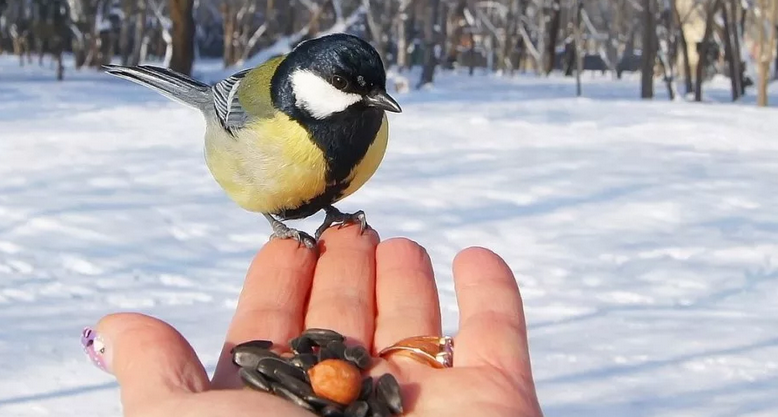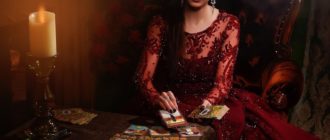If you do not know how to feed tits, then read the article. It has a lot of useful information.
Contents
- Popular types of tits: what do they eat?
- Tow - a migratory bird or not?
- What do blue usually eat in the city, in nature?
- What tits eat in winter - food for the blue: the recommendations of an ornithologist
- What can not be fed tits?
- Is it possible and how to feed the tit with fresh and salty lard?
- Is it possible and how to properly feed the titmouses with watermelon, raw and fried pumpkin and sunflower seeds?
- Is it possible to feed the tits with seeds of zucchini?
- Is it possible for tits oats, linen seed, pearl barley, Hercules, millet, focus for parrots?
- What cereals, grain can be given to the blue in winter?
- Is it possible to feed the tits with bread?
- Do the blue -bells eat rowan?
- Can tints give fish, meat?
- The most beloved treat of a blue
- How many times a day to feed the blue, how much food does a blue need in winter?
- Do I need to feed the blue in spring and summer?
- Interesting facts about todnie feeding
- Video: tastes of tits. Experiment with nuts and seeds
This bird too often falls on the eyes of many of us, and therefore is familiar to everyone. Small, pretty, mobile, fun fluttering from a branch to a branch - this is exactly the image of this bird in the imagination of every person. But many do not imagine that there are several species of these birds - more 65.
Residents of the family of tits can be found in different parts of the world. Read more about these birds below. You will find useful information about how they can be fed, as well as interesting facts and much more. Read further.
Popular types of tits: what do they eat?
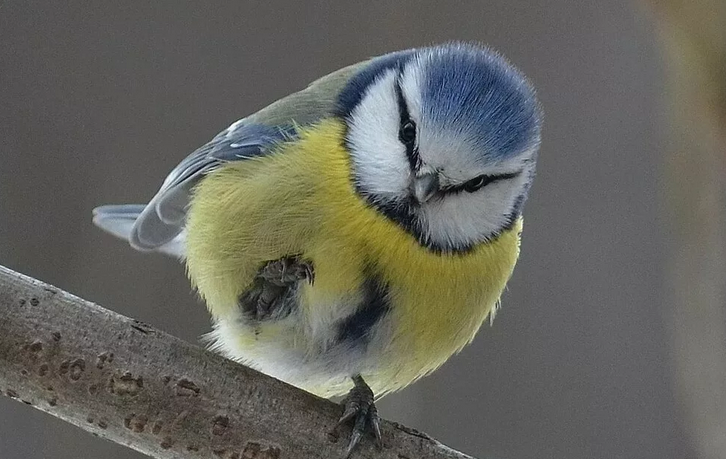
There is an erroneous belief that the title of the tint comes from the color of the coloring of the plumage. But in reality, the blue shade of feathers in these birds is rare. The name of birds comes from sounds "Si-Sin-Tsi"that they pronounce.
The most popular types of tits:
- The tit is big
- Crested
- Mustache
- Hanging
- Blue tit
- Pukhlyak
- Moskovka
Here is a description, and what these birds eat in nature, depending on the type:
Big Tit:
- The most recognizable species is a white, yellow -breasted bird with a black strip on the chest.
- She always accompanies people.
- A permanent place where these representatives of the species live - forests and parks of large cities.
- In the summer, it prefers nutrition with spider -shaped and bucks.
- But in winter is an ordinary visitor to the feeders.
- If you show patience, feeding these birds regularly in winter, you can accustom them to take food from the hand.
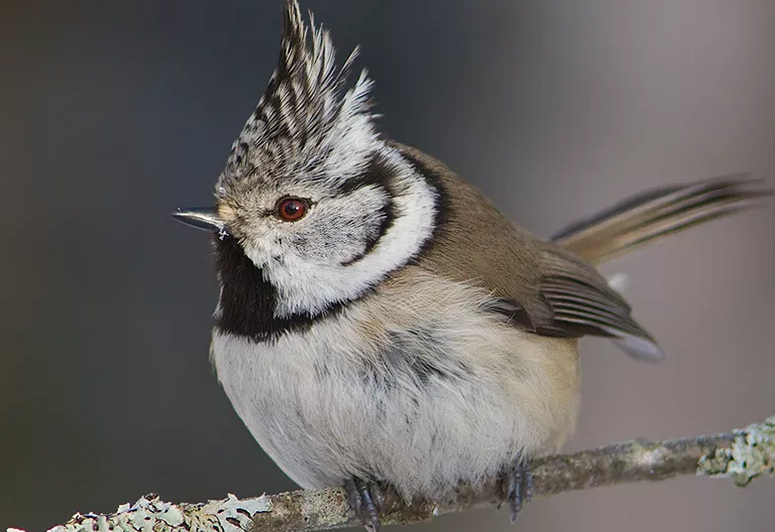
CHOCHAL TOP:
- They call a grenadier.
- A characteristic feature of this species is a sharp crest.
- The abdomen is not yellow, but white, with a brownish tint.
- Basically, hold solidly.
- In their diet there are invertebrates, berries, maple juices, aspen, birch.
- A distinctive feature of this species - in Europe it is the only small bird.
Substacked tit:
- It has only a visual resemblance to large, lasores, trays.
- These are birds the size of a smaller sparrow.
- They have exquisite coloring.
- Like other tits, migrated depending on the season.
- Live in thick reeds.
- In search of food - small snails, insects and their larvae, reed acrobats flutter from the stem to the stalk.
- Click on the constant roll calls among themselves.
- In winter, the mustachioed tits switch to seed feeds.
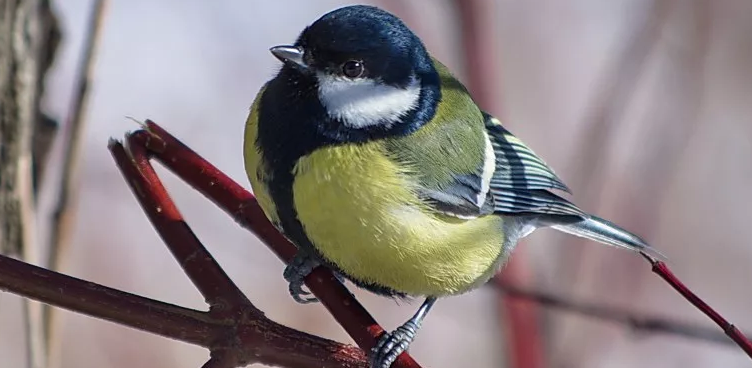
Slow down tit:
- Dexterous and energetic representatives of such birds.
- They are excellent masters in building a nest.
- Low above the ground, it is suspended at the ends of the branches of shrubs or trees.
- These are housing with thick walls in the form of a pear with the entrance from the side.
- To get inside, the bird hangs on the tube, with the help of paws and wings opens the entrance.
Blue tit:
- A view differing from the mosquitoes that have chosen the needles.
- They live in deciduous forests.
- Sets at rivers and swamps, in aspen groves.
- Eats all insects.
- Eats little and only when hungry.
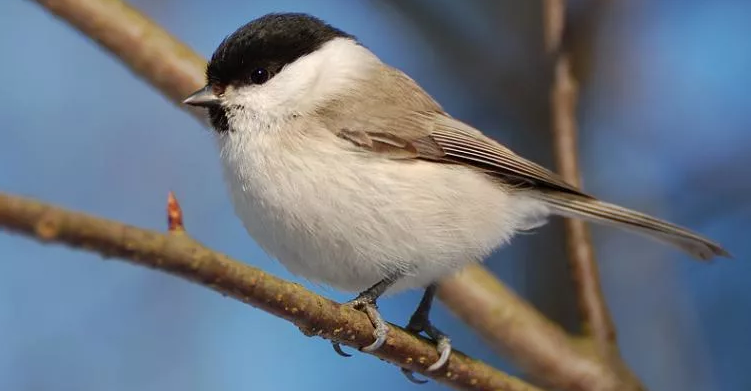
Pukhlyak:
- The bird is smaller than the sparrow, very similar to a tray.
- Modest colors, contrasting black hat, white cheeks.
- Mostly lives in coniferous forests.
- Severe winters are easily worried provided for a sufficient amount of food.
- Live in small flocks in pairs for most of the year.
- In flocks, a difficult hierarchy is opened, which depends on the age and floor of birds.
Moskovka:
- An incredibly cute creation with a pleasant voice - this way you can briefly describe these tits.
- The appearance with a big blue is very similar.
- But in size, twice are smaller and the brisket is light gray, without a black strip.
- Moskovka cannot be met in settlements.
- Here she does not live.
- But, despite this, it is the most gullible bird.
Read further interesting and useful information about these birds.
Tow - a migratory bird or not?
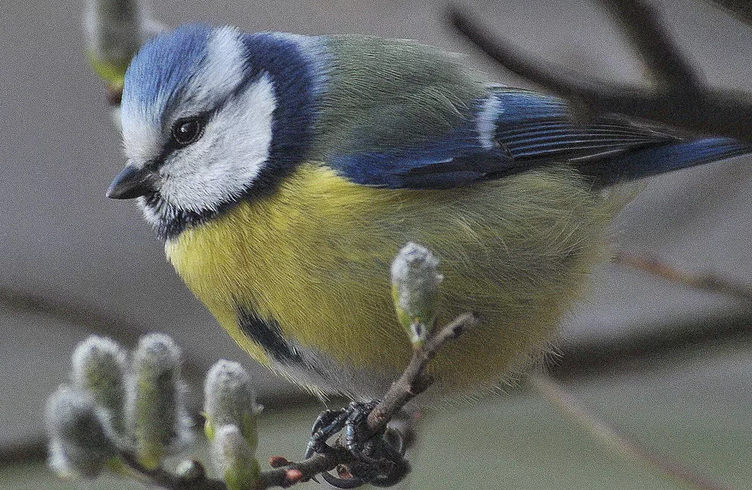
To understand whether the tits belong to the group of migratory birds or not, it is worth considering the question of why some birds generally fly to the warm lands. There are those that remain winter on the spot.
- The lack of sufficient supply of food is the main motivation for flights.
- To survive in the harsh conditions of winter, birds need to eat well.
- Most of them eat food of animal origin, that is, insects. Such products find a problem in winter.
- Another important reason is the cold.
Regarding tits, most of its species are nomads. With the advent of cold time, they approach the housing of people, hoping to get food supplies here for the whole winter. Tits do not belong to migratory birds. They are not too sensitive to low temperatures and can adapt to different conditions of existence.
What do blue usually eat in the city, in nature?
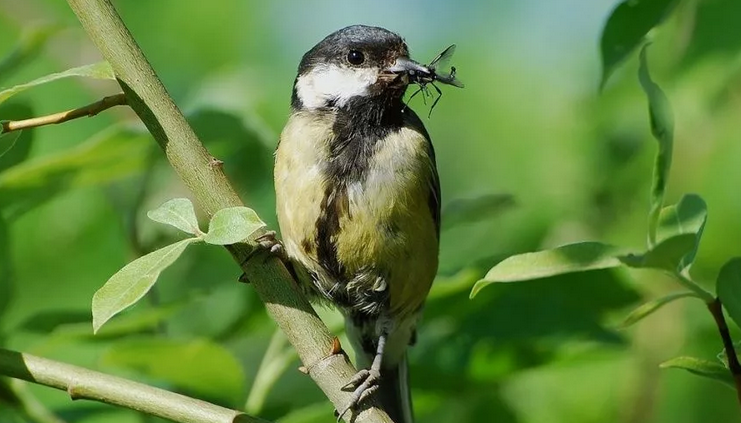
In the city in the winter, found foods is easier to find food than in nature. Although these birds can get it without human help, they do not neglect the opportunity to eat from the feeders. The best food in suspended houses is the seeds of wheat, oats, corn.
Interesting: In nature, in the difficult conditions of winters, the titmouses show the extreme ability to use any opportunity to get food. In the oaks, flocks of these birds are everywhere accompanying wild pigs. Indeed, in the tearing deciduous litters there is always something delicious.
Tits willingly feed on leaflets, weevils, butterflies and spiders. With pleasure they eat flies and mosquitoes, aphids, ants and even bees and OS. It is worth noting, for example, the crested bits resort to the workpiece of small food reserves for the winter - they hide spiders and insects, different seeds in the cracks of trees cortex. These small supplies in difficult winter times give a chance of survival. Often it happens that reserves made by the crests are helped out in the cold and other birds.
In the beginning of spring, the main food for the blue is the boot of aspen, and they also drink maple and birch juices.
What tits eat in winter - food for the blue: the recommendations of an ornithologist
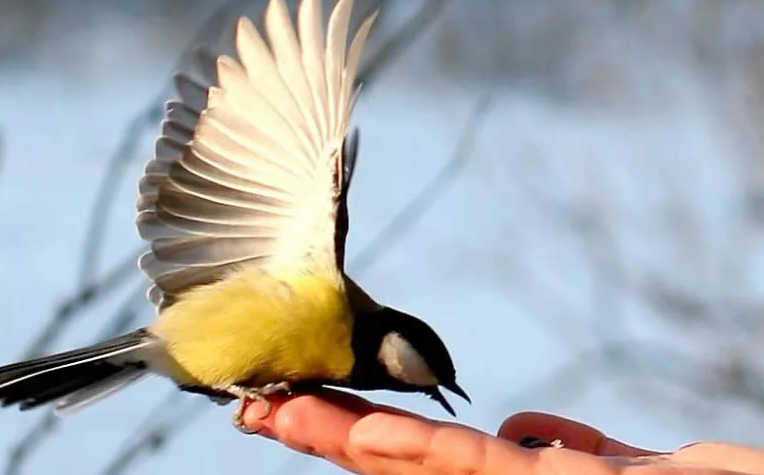
In the winter, when birds cannot in sufficient quantities get their food, people should take care of them. They often make feeders for birds, but do not know what exactly can be put in them. Someone pours millet or other cereal as a feed for a turning point, others feed the birds with bread. But what can you eat this feathered? Here are the recommendations of the ornithologist:
- As a feed, you can use a mixture of cereals, crackers, carrots.
- With great pleasure, the blue worms are eaten.
- Appetizingly slack pieces of apple, drying from berries, nuts.
- They love tits of seeds: pumpkin, sunflower, linen. But only in raw form, from fried seeds can they get sick.
- The body of such a bird also needs a variety of mixed food. For example, a mixture of egg yolks and protein, different grains, white crackers.
Remember: It is forbidden to give tits to give any yeast bread. They get sick and die from him.
What can not be fed tits?
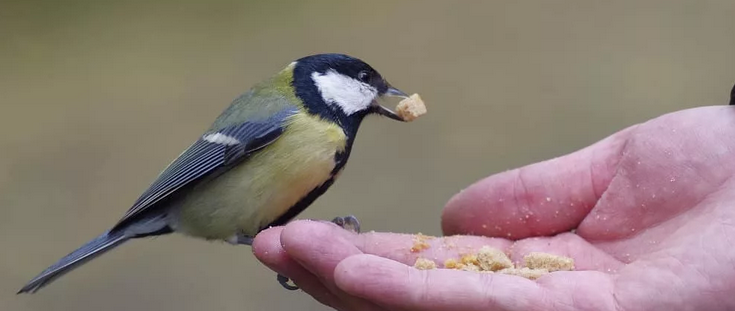
It has already been described above that it is impossible to eat tips. Let us summarize in more detail - they are forbidden to feed:
- Yeast bread
- Fried seeds
- Smoked, salty lard, meat, fish
- Peas
- Potatoes, cabbage, onions
- Dairy products
- Sharp products
- Dry and raw cereal
- Spoiled molds of food
- Millet
- Pucking grain
Pay attention to this list. If the birds are constantly eating such feeds, they can die. But they trust a person and is very necessary for nature and people. Therefore, before putting food in a suspended house, think about whether a blue can be a cereal, lard or even more meat. Read more below.
Is it possible and how to feed the tit with fresh and salty lard?

Everyone knows that the hoibs like to enjoy the fat. I would like to describe this item separately, since people are sure that this is a favorite treat of such birds. It helps the bird to draw the necessary fat layer to maintain heat in the cold. In addition, tits are predator birds, and they really like such a product. You can put a piece of fat in the feeder.
It's important to know: Birds in nature consume unsalted food, so salt can harm them. Salty lard causes bird's abdominal pain.
In the long term, such a product triggers the process of accumulating salt in the body of a bird, and can lead to its subsequent death.
Remember: Do not feed the birds smoked, pickled, salty fat. This product can only be raw and fresh.
Such birds can be given not only fresh lard, but also pork skin, and chipworms. Here is a recipe for cooking with stomped fat:
- Cut the pork lard or interior fat into pieces and punch on low heat.
- Then, in hot form, pour it into a plastic mold.
- For the contrast of tastes, you can add any seeds in a small amount to this bilged mixture.
- Leave it to harden, then take it out of the mold and hang on a tree. You can wrap a piece of fat with a rope and hang on a branch.
Is it possible and how to properly feed the titmouses with watermelon, raw and fried pumpkin and sunflower seeds?
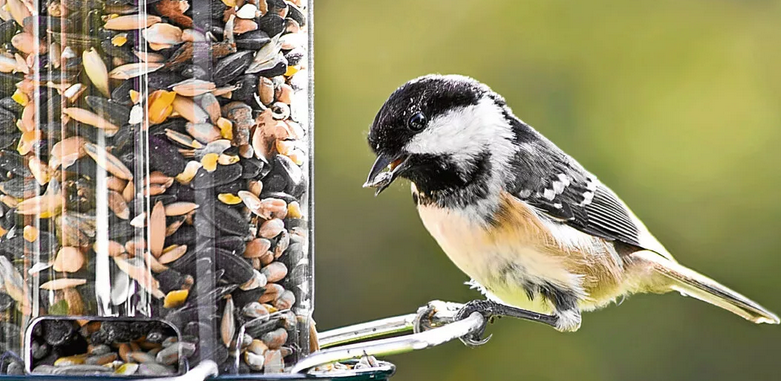
Tints can eat seeds - watermelon, pumpkin, sunflower. But as mentioned above, it is not recommended to give them fried seeds. From raw such products, you can also seeds of melon, hemp, flax, dill. These feathered seeds from cones - coniferous, cedar are very fond of. You can give the seeds of the seeds of weeds and herbs.
Is it possible to feed the tits with seeds of zucchini?
The seeds of zucchini are also a favorite treat for tits. It is worth preparing these seeds in the fall. But naturally, they should not be fried, not bad and not moldy. Therefore, if you have the opportunity to feed these birds with such food, then they will be grateful to you for this.
Is it possible for tits oats, linen seed, pearl barley, Hercules, millet, focus for parrots?
Everyone believes that millet is suitable as a feed for tits and other birds:
- Indeed, earlier in the village, our grandparents fed representatives of birds from the household precisely millet.
- The fact is that they gave the bird to the bird, and the yellow polished millet cereal, which is now sold in stores, is very oxidized.
- Manufacturers began to use modern purification technologies that make this cereal not suitable for food, especially to birds, since they have a delicate stomach.
Oats, linen seed, pearl barley, Hercules can be given tits. Parrons feed will also like feathered, and will be safe for them. They themselves will choose delicious ones for themselves.
It is worth noting: From the range of food for birds sold in the pet store, all feeds for insectivorous birds, and even grain mixtures for canaries are suitable for tits.
What cereals, grain can be given to the blue in winter?
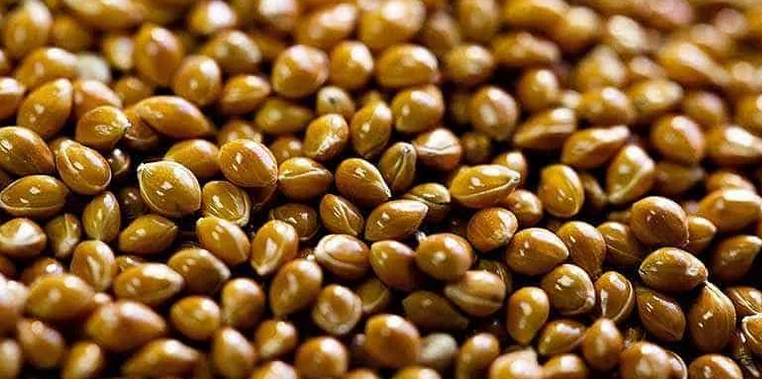
People are used to feeding birds of different cereals. She is always in the house, cheaply stands and like feathered. Above, we found out that it is forbidden to give millet to it. Buckwheat, yachka, moldy and runaway grain are not recommended. What other cereals can be given to the blue in winter? Here is a list of the most healthy feed of grain crops for these birds:
- Millet
- Oats
- Crouping rice
- Pearl barley
- Oatmeal - dense, large grinding
- Hercules from packs
One of these cereals will certainly be found in any house. Therefore, if you decide to feed the blue, then do not put them bread or millet, but only cereals from this list.
Is it possible to feed the tits with bread?
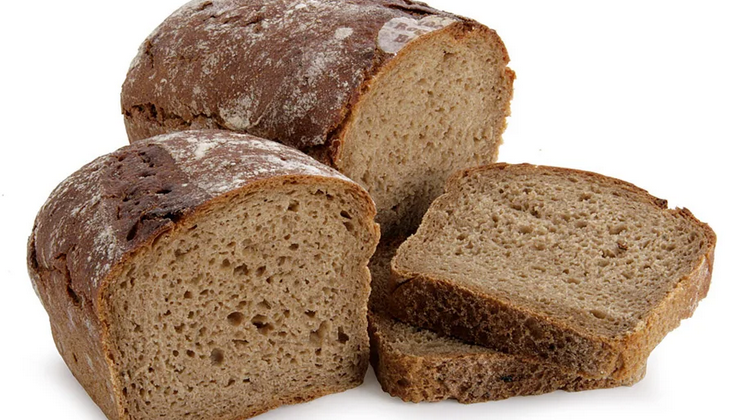
It was said above that tits, like other birds, are forbidden to feed bread. In particular, they cannot be black or rye crumb.
- Rye (black) bread can greatly harm the blue.
- He begins to wander already in the goiter of the bird.
- This process is menacingly difficult to breathe, as the gases expand the goiter, and the goose compresses the trachea.
White is better, but it is better to do without it:
- Fresh white (wheat) bread in the stomach turns into an adhesive mass and causes digestion.
- This mass barely moves along the digestive tract.
Remember: do not offer the Sinichi moldy bread. He is able to harm not only feathered, but also people.
Ornithologists recommend that if you want to feed the tit with bread, then it should be whole -grain and idle.
Do the blue -bells eat rowan?
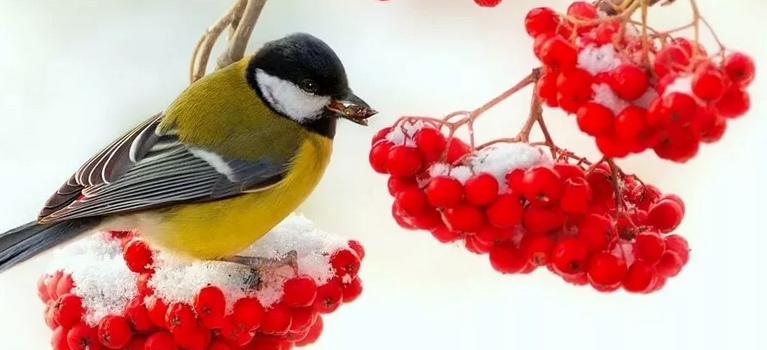
As an additive to the main food, tits are consumed by the seeds of beech, maple, linden, birch, lilacs, an elderberry, horse sorrel. These birds do not ignore various varieties of berries as a treat. They eat fruits of Irgi, blueberries, mountain ash. You can also give blue berries of hawthorn, cranberries, lingonberries.
Can tints give fish, meat?
At the time of cold weather, tits can be fed with low -fat meat, fish. Unsalized boiled meat, as well as the cooked fish, will definitely be a welcome treat for these bright birds.
Many people even give a sausage cut into pieces. But ornithologists do not advise doing this, since in sausage from modern manufacturers, there is no meat. In the best case, the composition has milk, the rest is chemical additives. Accordingly, such a product will not be beneficial, but can only harm.
The most beloved treat of a blue

It is difficult to allocate one beloved one from the entire list of Sinichkins. They consume so many things with great pleasure in the diet of their diet. In nature, the most beloved delicacy of Sinichka will be one type of food, and in the city - in feeders, such feathered preference gives another food.
You can distinguish from the entire list of favorite treats of tits, a whole peanut nucleus can be. Also, a treat in the form of worms is the favorite food of any birds. It gets it by nature and sometimes they can find such a yummy for themselves and in the feeder if a person puts it there. Flour worms, like ants for insectivorous birds are the most important and healthy food.
How many times a day to feed the blue, how much food does a blue need in winter?
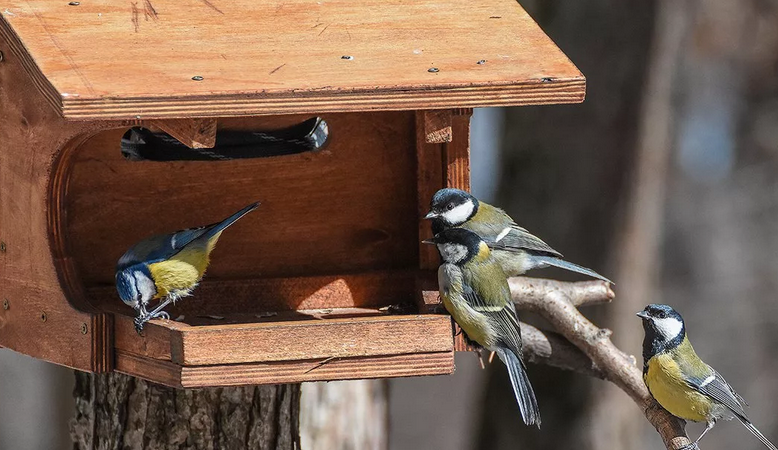
We should not forget that tits only need to be fed. So not give them excessively a lot of food so as not to harm kindness. Birds can not lose the habit of getting food on their own. How many times a day to feed the blue, how much is the norm in winter? Here's the answer:
- These birds need to be fed regularly - 2-3 times a day.
- It is important to add food to the feeder every time at the same time.
- So the tits develop a conditioned reflex, and they will always fly to where there is always food.
If there is no way to feed, for example, 2 times a day, let's once, but every morning. Birds will already know this and will begin to fly to your feeder in the morning. In addition, it is important not how much food you will give. It is necessary to ensure that the cereal does not stick under the snow, that is, the feeders should be closed from above and it is necessary not only to add grain daily, but also to remove the old food in this suspended house. Therefore, put a little bit. Then it is better to add fresh grain.
Do I need to feed the blue in spring and summer?

Ornithologists believe that in the spring and summer, when the marriage period and the time of reproduction of offspring continue, do not feed the blue. They are insectivorous and they feed their chicks with living insects - small caterpillars, butterflies. So at this time, tits should themselves provide food.
Interesting: A long -tailed tit, flying and jumping through the branches, practices various acrobatic tricks. To find and catch insects, this small fluffy ball is suspended from the bottom to the branch and carefully examines the shoots.
It is very interesting to monitor such behavior.
Interesting facts about todnie feeding
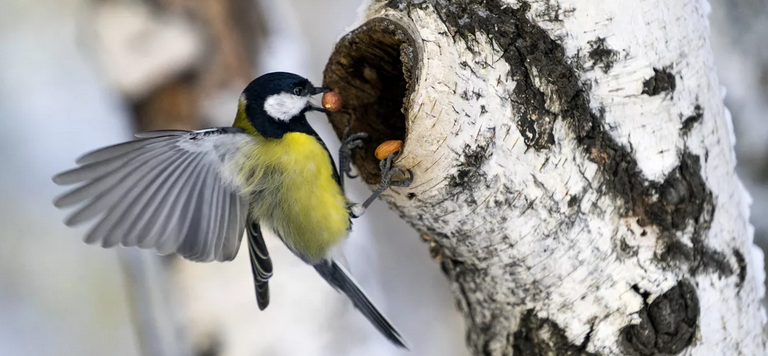
A tit is a useful bird. In addition, it is very interesting in behavior and type of eating. Here are interesting facts about feeding tits:
- In one day in the summer it can eat before 300-400 caterpillars.
- Tits are very gullible and malleable to taming. Even completely shy birds can be fed from the palm of your hand.
- In flight, he rarely waves wings. But this does not prevent them from flying quickly and looking for prey.
- Such birds feed offspring 30-40 times per hour. This is approximately 1000 departures per day.
- Tits have a phenomenal memory. They remember the places rich in food well.
- In natural conditions live 1-3 years. In captivity, they can live to 15 years. Such a large life expectancy is explained by good living conditions and the presence of constant feed.
- Previously, in Russia there was a decree providing for a huge fine for the murder of a tint.
As you can see, these birds will not survive without our help. Make feeders and feed such interesting birds so that they can clean the gardens from the invasion of insects in spring and summer. Good luck!
Video: tastes of tits. Experiment with nuts and seeds
Read on the topic:

